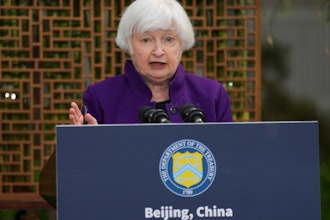The dollar mostly gained Thursday after reports suggesting unemployment rose and manufacturing declined in the U.S.
Other traditional safe haven currencies, the Japanese yen and Swiss franc, strengthened against the dollar because of the prospect of slower growth in the U.S., however. The dollar nearly touched a 15-year low versus the yen earlier in the day.
The euro, used by 16 European countries, dropped to $1.2824 in late trading Thursday in New York from $1.2865 late Wednesday.
The British pound dipped $1.5596 from $1.5608. The dollar rose to 1.0395 Canadian dollars from 1.0276 Canadian dollars. It was also higher versus the Australian and New Zealand dollars, the Scandinavian currencies and the major currencies of Latin America.
The dollar dropped versus the yen and Swiss franc, though, as the two safe-haven currencies advanced broadly. The dollar fell to 85.32 yen late Thursday from 85.46 Wednesday. It earlier touched as low as 84.90 yen, just above a 15-year low of 84.75 yen hit on Aug. 11.
The U.S. currency also fell to 1.0331 Swiss francs from 1.0419 Swiss francs.
Treasury yields and gold also rose. U.S. government debt is considered one of the safest investments. Yields fall when prices rise.
"The (dollar) appears to be settling into a range ... supported by safe-haven demand at one end and capped by weakening fundamentals on the other end," said Michael Woolfolk, senior currency strategist at Bank of New York Mellon in a research note.
Driving trading Thursday was bad news on jobs and manufacturing. The government said that initial claims for jobless aid rose by 12,000 last week to 500,000. It's the first time weekly jobless claims have hit 500,000 since November, suggesting that layoffs are increasing and the gradual improvements in the labor markets this year may be receding.
A regional report on manufacturing from the Federal Reserve of Philadelphia also showed a big decline in the area during August.
Manufacturing has led the recovery from the recession for a year. If the sector weakens across the country, that would weigh on economic growth and hiring.
The weakening U.S. economy is weighing on the dollar's safe-haven appeal in part because investors think the Federal Reserve may take further steps if prices start falling. Analysts say that if the Fed starts buying bonds, that could weigh on the dollar. Such measures could trigger inflation in the long run, and they would bring down yields on bonds bought with dollars, making such bets less attractive to investors.
James Bullard, president of the Federal Reserve Bank of St. Louis, said Thursday in a speech in Rogers, Ark., that the Fed may start buying more Treasurys if the risk of disinflation — or slowing inflation — increases. That would expand a program announced earlier this month. The Fed has committed to buying Treasurys from proceeds of mortgage-backed securities in an attempt to bring down interest rates on mortgages and loans and help spark economic activity.






















